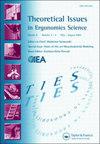A theoretical model of industrial accidents investigations: a conceptualization of the mental processes that trigger and control investigative activities
IF 1.4
Q4 ERGONOMICS
引用次数: 0
Abstract
AbstractHumans strive to understand and respond to abnormal changes that occur within their surrounding contexts. Current literature is yet to discuss the process of triggering an enquiring process within the human cognition after the occurrence of an unforeseen change event or an accident, to explain what behavioral response can follow, and to recognize what factors shape such a response. This article presents a new theoretical model – tagged as the ‘Slammed Adjacent Door (SAD)’ model that addresses the behaviour of an individual responder to a simple change event, which is expanded to discuss the wider social and organizational behaviour relevant to an accident. The model establishes the link between the preliminary cognition of potential investigators and their following practical response to an accident, by discussing the dynamic interactions of various endogenous and exogenous factors that trigger and control their post-event investigative actions. According to the SAD model, an industrial accident investigation is a six-phased sequence of mental manipulations, decisions, and physical actions that are initiated, motivated, and sustained by complex mutually-influencing personal, organizational, and wider set of input factors. The model has consequential set of theoretical and practical implications relating to organizational or other incidents and accidents investigations.Keywords: Accidents investigationstheoretical modellinghuman cognition and behavioursafetyorganizational behaviour Disclosure statementNo potential conflict of interest was reported by the author(s).工业事故调查的理论模型:触发和控制调查活动的心理过程的概念化
人类努力理解和应对周围环境中发生的异常变化。目前的文献尚未讨论在不可预见的变化事件或事故发生后,在人类认知中触发一个探究过程的过程,解释什么行为反应可以遵循,并认识到什么因素塑造了这样的反应。本文提出了一个新的理论模型-标记为“关闭相邻门(SAD)”模型,该模型解决了单个响应者对简单变化事件的行为,该模型扩展到讨论与事故相关的更广泛的社会和组织行为。该模型通过讨论触发和控制调查人员事后调查行动的各种内源性和外源性因素的动态相互作用,建立了潜在调查人员的初步认知与他们随后对事故的实际反应之间的联系。根据SAD模型,工业事故调查是一个由心理操纵、决策和身体行动组成的六个阶段序列,这些过程由复杂的相互影响的个人、组织和更广泛的输入因素发起、激发和维持。该模型对组织或其他事件和事故的调查具有相应的理论和实践意义。关键词:事故调查;理论建模;人的认知与行为;
本文章由计算机程序翻译,如有差异,请以英文原文为准。
求助全文
约1分钟内获得全文
求助全文

 求助内容:
求助内容: 应助结果提醒方式:
应助结果提醒方式:


